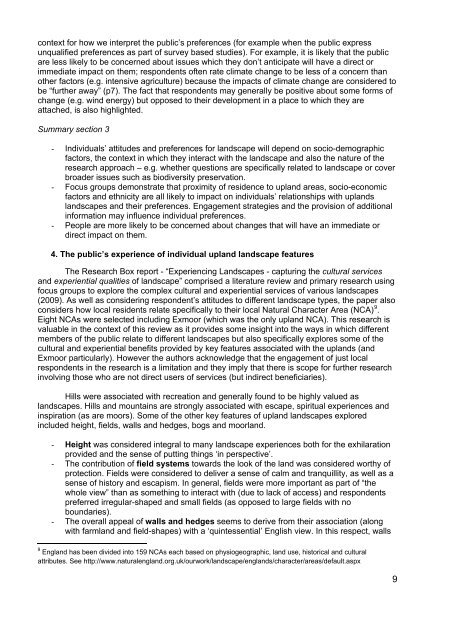Public Attitudes and Preferences for Upland Landscapes - Defra
Public Attitudes and Preferences for Upland Landscapes - Defra
Public Attitudes and Preferences for Upland Landscapes - Defra
You also want an ePaper? Increase the reach of your titles
YUMPU automatically turns print PDFs into web optimized ePapers that Google loves.
context <strong>for</strong> how we interpret the public’s preferences (<strong>for</strong> example when the public express<br />
unqualified preferences as part of survey based studies). For example, it is likely that the public<br />
are less likely to be concerned about issues which they don’t anticipate will have a direct or<br />
immediate impact on them; respondents often rate climate change to be less of a concern than<br />
other factors (e.g. intensive agriculture) because the impacts of climate change are considered to<br />
be “further away” (p7). The fact that respondents may generally be positive about some <strong>for</strong>ms of<br />
change (e.g. wind energy) but opposed to their development in a place to which they are<br />
attached, is also highlighted.<br />
Summary section 3<br />
- Individuals’ attitudes <strong>and</strong> preferences <strong>for</strong> l<strong>and</strong>scape will depend on socio-demographic<br />
factors, the context in which they interact with the l<strong>and</strong>scape <strong>and</strong> also the nature of the<br />
research approach – e.g. whether questions are specifically related to l<strong>and</strong>scape or cover<br />
broader issues such as biodiversity preservation.<br />
- Focus groups demonstrate that proximity of residence to upl<strong>and</strong> areas, socio-economic<br />
factors <strong>and</strong> ethnicity are all likely to impact on individuals’ relationships with upl<strong>and</strong>s<br />
l<strong>and</strong>scapes <strong>and</strong> their preferences. Engagement strategies <strong>and</strong> the provision of additional<br />
in<strong>for</strong>mation may influence individual preferences.<br />
- People are more likely to be concerned about changes that will have an immediate or<br />
direct impact on them.<br />
4. The public’s experience of individual upl<strong>and</strong> l<strong>and</strong>scape features<br />
The Research Box report - “Experiencing L<strong>and</strong>scapes - capturing the cultural services<br />
<strong>and</strong> experiential qualities of l<strong>and</strong>scape” comprised a literature review <strong>and</strong> primary research using<br />
focus groups to explore the complex cultural <strong>and</strong> experiential services of various l<strong>and</strong>scapes<br />
(2009). As well as considering respondent’s attitudes to different l<strong>and</strong>scape types, the paper also<br />
considers how local residents relate specifically to their local Natural Character Area (NCA) 9 .<br />
Eight NCAs were selected including Exmoor (which was the only upl<strong>and</strong> NCA). This research is<br />
valuable in the context of this review as it provides some insight into the ways in which different<br />
members of the public relate to different l<strong>and</strong>scapes but also specifically explores some of the<br />
cultural <strong>and</strong> experiential benefits provided by key features associated with the upl<strong>and</strong>s (<strong>and</strong><br />
Exmoor particularly). However the authors acknowledge that the engagement of just local<br />
respondents in the research is a limitation <strong>and</strong> they imply that there is scope <strong>for</strong> further research<br />
involving those who are not direct users of services (but indirect beneficiaries).<br />
Hills were associated with recreation <strong>and</strong> generally found to be highly valued as<br />
l<strong>and</strong>scapes. Hills <strong>and</strong> mountains are strongly associated with escape, spiritual experiences <strong>and</strong><br />
inspiration (as are moors). Some of the other key features of upl<strong>and</strong> l<strong>and</strong>scapes explored<br />
included height, fields, walls <strong>and</strong> hedges, bogs <strong>and</strong> moorl<strong>and</strong>.<br />
- Height was considered integral to many l<strong>and</strong>scape experiences both <strong>for</strong> the exhilaration<br />
provided <strong>and</strong> the sense of putting things ‘in perspective’.<br />
- The contribution of field systems towards the look of the l<strong>and</strong> was considered worthy of<br />
protection. Fields were considered to deliver a sense of calm <strong>and</strong> tranquillity, as well as a<br />
sense of history <strong>and</strong> escapism. In general, fields were more important as part of “the<br />
whole view” than as something to interact with (due to lack of access) <strong>and</strong> respondents<br />
preferred irregular-shaped <strong>and</strong> small fields (as opposed to large fields with no<br />
boundaries).<br />
- The overall appeal of walls <strong>and</strong> hedges seems to derive from their association (along<br />
with farml<strong>and</strong> <strong>and</strong> field-shapes) with a ‘quintessential’ English view. In this respect, walls<br />
9 Engl<strong>and</strong> has been divided into 159 NCAs each based on physiogeographic, l<strong>and</strong> use, historical <strong>and</strong> cultural<br />
attributes. See http://www.naturalengl<strong>and</strong>.org.uk/ourwork/l<strong>and</strong>scape/engl<strong>and</strong>s/character/areas/default.aspx<br />
9
















